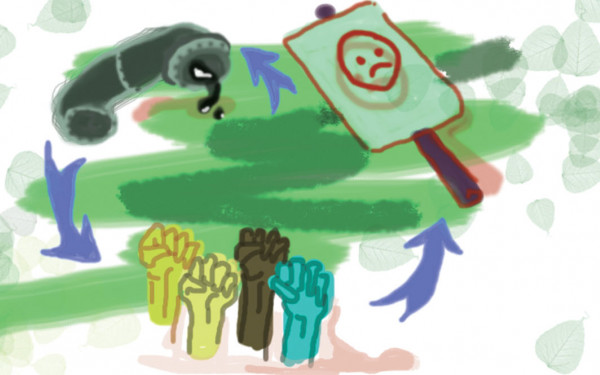Activists Bill McKibben, Ellen Gabriel Speak at Concordia
Indigenous, Migrant Rights Tie into Climate Justice
The links between indigenous rights, migrant justice and environmental activism were explored at this academic year’s first major speaking event on Wednesday, when a few hundred students turned up to listen to activists Bill McKibben and Ellen Gabriel in Concordia’s Alumni Auditorium.
“We have taken a beautiful world and we have begun the process of really de-creating it,” McKibben told an attentive audience.
McKibben is the founder of 350.org, a website devoted to environmental activism on an international scale.
The movement takes its name from the fact that many climate scientists argue the concentration of carbon dioxide in the atmosphere should be reduced to 350 parts per million, a “safe” level.
The speech was given in promotion of the People’s Climate March, a mobilization drawing attention to the UN Climate Summit happening later this month.
McKibben outlined his beginnings in activism and explained the importance of action to the crowd.
“About 25 years ago, [scientists] gave us pretty much an unequivocal warning about climate change. […] They told us what was going to happen, and nobody did anything,” he explained.
“The problem above all problems [is that] the fossil fuel industry is the richest industry there ever was, and that’s not hyperbole. Exxon made more money last year than any company in the history of money. And, when you have that kind of money, it buys you a lot more political influence than you actually deserve to have.”
Ellen Gabriel, a Mohawk human rights activist and artist, echoed McKibben’s views on the corporate role in environmental decay.
“Stephen Harper [and] whoever the CEOs and the board of directors of TransCanada and Enbridge are, I accuse them of crimes against humanity,” she said.
Gabriel cited potential leakage of the harmful chemicals used in fracking and other forms of oil extraction as reasons for her accusation.
Gabriel said indigenous communities are often those most affected by climate change. She told audience members that, according to the UN Commission on Human Rights, “resource extraction is the most pressing and most urgent [problem] in regards to the violation of indigenous peoples’ rights throughout not just the Americas, but throughout the world.”
In a similar vein, Shaina Agbayani, a Filipino climate justice activist, encouraged audience members to think of “climate justice as migrant justice [and] as indigenous solidarity.”
Agbayani had just returned from the Global Power Shift conference in the Philippines.
“A major question for me, coming back to Canada in predominantly white climate justice organizing contexts, is how do we make our movements more inclusive?” she said.
“It took about 20 minutes of watching these pictures […] to realize that […] most of the people around the world who were taking up this cause were poor and black and brown and Asian and young,” – Bill McKibben
Agbayani explained that her mother was driven to move to Canada under the live-in caregiver program because she couldn’t sustain her family in her country of origin. She highlighted the fact that this was despite the fact that the Philippines has enough natural resources to sustain its population five times over.
“The reality is that the way that natural resources are being mismanaged, expropriated, exploited, particularly by foreign corporations, [prevents it from] being channeled to the local communities,” she said, adding that Filipinos are pushed by this external influence to immigrate to more prosperous countries en masse.
Agbayani concluded by saying the close relationship between emigration and climate change means that “migrant justice work is a form of climate justice work,” because it involves the people most affected by climate change.
McKibben also touched on the role of indigenous peoples and citizens of the Global South in environmental activism, when speaking about the International Day of Climate Action, 350.org’s first international mobilization to draw attention to climate change.
“I’ve always been told that environmentalism is something that only rich white people that didn’t have to work [could participate in],” he said.
“It took about 20 minutes of watching these pictures [from the International Day of Climate Action] come in to realize that that was nonsense, that most of the people around the world who were taking up this cause were poor and black and brown and Asian and young.”
McKibben said the environmental movement benefited from “the leadership of especially the indigenous communities.” At this point, McKibben was interrupted by audience member Amanda Lickers.
“There is no acknowledgement of indigenous territories whatsoever,” Lickers said of the People’s Climate March.
Lickers is an indigenous activist, who supports First Nations’ struggles against resource extraction, particularly in the oil sands.
“Many community organizers in New York City who belong to racialized communities, who were impacted by Hurricane Sandy, are not being meaningfully included,” she said.
Lickers posited that the march instated “white organizers as authorities in boroughs that are predominantly black.”
She also claimed that 350.org had partnered “with Zionist organizations which [support] the Palestinian occupation,” citing Young Judaea, the Green Zionist Alliance and the UJA Federation.
McKibben didn’t acknowledge the interruption, but said the march “included people who had lived through Hurricane Sandy.”
Of McKibben’s response to her comment, Lickers said, “he didn’t address it, […] he basically said, ‘we have enough resources that we can make sure it’s brown people in the front, and we can look like we have a real anti-colonial praxis, a real anti-racist praxis,’ and it’s just not true.”
CORRECTION: This article originally stated that climate scientists argue “the ratio of carbon dioxide to other molecules in the atmosphere should be reduced to 350 parts per million.” In fact, 350 parts per million refers to a safe concentration of carbon dioxide in the atmosphere, according to scientists. The article has been update accordingly. The Link regrets the error.

_900_597_90.jpg)



